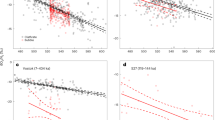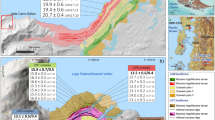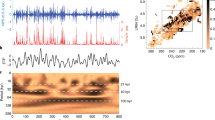Abstract
The Milankovitch theory of climate change proposes that glacial–interglacial cycles are driven by changes in summer insolation at high northern latitudes1. The timing of climate change in the Southern Hemisphere at glacial–interglacial transitions (which are known as terminations) relative to variations in summer insolation in the Northern Hemisphere is an important test of this hypothesis. So far, it has only been possible to apply this test to the most recent termination2,3, because the dating uncertainty associated with older terminations is too large to allow phase relationships to be determined. Here we present a new chronology of Antarctic climate change over the past 360,000 years that is based on the ratio of oxygen to nitrogen molecules in air trapped in the Dome Fuji and Vostok ice cores4,5. This ratio is a proxy for local summer insolation5, and thus allows the chronology to be constructed by orbital tuning without the need to assume a lag between a climate record and an orbital parameter. The accuracy of the chronology allows us to examine the phase relationships between climate records from the ice cores6,7,8,9 and changes in insolation. Our results indicate that orbital-scale Antarctic climate change lags Northern Hemisphere insolation by a few millennia, and that the increases in Antarctic temperature and atmospheric carbon dioxide concentration during the last four terminations occurred within the rising phase of Northern Hemisphere summer insolation. These results support the Milankovitch theory that Northern Hemisphere summer insolation triggered the last four deglaciations3,10,11.
This is a preview of subscription content, access via your institution
Access options
Subscribe to this journal
Receive 51 print issues and online access
$199.00 per year
only $3.90 per issue
Buy this article
- Purchase on Springer Link
- Instant access to full article PDF
Prices may be subject to local taxes which are calculated during checkout




Similar content being viewed by others
References
Hays, J. D., Imbrie, J. & Shackleton, N. J. Variations in the Earth’s orbit: Pacemaker of ice ages. Science 194, 1121–1132 (1976)
Clark, P. U., McCabe, A. M., Mix, A. C. & Weaver, A. J. Rapid rise of sea level 19,000 years ago and its global implications. Science 304, 1141–1144 (2004)
Alley, R. B., Brook, E. J. & Anandakrishnan, S. A northern lead in the orbital band: North-south phasing of ice-age events. Quat. Sci. Rev. 21, 431–441 (2002)
Ikeda-Fukazawa, T. et al. Effects of molecular diffusion on trapped gas composition in polar ice cores. Earth Planet. Sci. Lett. 229, 183–192 (2005)
Bender, M. L. Orbital tuning chronology for the Vostok climate record supported by trapped gas composition. Earth Planet. Sci. Lett. 204, 275–289 (2002)
Petit, J. R. et al. Climate and atmospheric history of the past 420,000 years from the Vostok ice core, Antarctica. Nature 399, 429–436 (1999)
Watanabe, O. et al. Homogeneous climate variability across East Antarctica over the past three glacial cycles. Nature 422, 509–512 (2003)
Kawamura, K. et al. Atmospheric CO2 variations over the last three glacial-interglacial climatic cycles deduced from the Dome Fuji deep ice core, Antarctica using a wet extraction technique. Tellus B 55, 126–137 (2003)
Spahni, R. et al. Atmospheric methane and nitrous oxide of the late Pleistocene from Antarctic ice cores. Science 310, 1317–1321 (2005)
Raymo, M. E. The timing of major climate terminations. Paleoceanography 12, 577–585 (1997)
Parrenin, F. & Paillard, D. Amplitude and phase of glacial cycles from a conceptual model. Earth Planet. Sci. Lett. 214, 243–250 (2003)
Parrenin, F., Remy, F., Ritz, C., Siegert, M. J. & Jouzel, J. New modeling of the Vostok ice flow line and implication for the glaciological chronology of the Vostok ice core. J. Geophys. Res. 109 doi: 10.1029/2004JD004561 (2004)
Parrenin, F. et al. The EDC3 agescale for the EPICA Dome C ice core. Clim. Past Discuss. 3, 575–606 (2007)
Shackleton, N. J. The 100,000-year ice-age cycle identified and found to lag temperature, carbon dioxide, and orbital eccentricity. Science 289, 1897–1902 (2000)
Ruddiman, W. F. & Raymo, M. E. A methane-based time scale for Vostok ice. Quat. Sci. Rev. 22, 141–155 (2003)
Bender, M. L. et al. Gas age-ice age differences and the chronology of the Vostok ice core, 0–100 ka. J. Geophys. Res. 111 doi: 10.1029/2005JD006488 (2006)
Severinghaus, J. P. & Battle, M. Fractionation of gases in polar ice during bubble close-off: New constraints from firn air Ne, Kr, and Xe observations. Earth Planet. Sci. Lett. 244, 474–500 (2006)
Blunier, T. & Brook, E. J. Timing of millennial-scale climate change in Antarctica and Greenland during the last glacial period. Science 291, 109–112 (2001)
Suwa, M. Chronologies for Ice Cores Constrained by their Gas Records and their Implications for Climate History for the Past 400,000 Years. Ph.D. thesis. Princeton Univ. (2007)
Vimeux, F., Cuffey, K. M. & Jouzel, J. New insights into Southern Hemisphere temperature changes from Vostok ice cores using deuterium excess correction. Earth Planet. Sci. Lett. 203, 829–843 (2002)
Loulergue, L. et al. New constraints on the gas age-ice age difference along the EPICA ice cores, 0–50 kyr. Clim. Past Discuss. 3, 435–467 (2007)
Lorius, C. et al. A 150,000-year climatic record from Antarctic ice. Nature 316, 591–596 (1985)
Henderson, G. M. & Slowey, N. C. Evidence from U-Th dating against Northern Hemisphere forcing of the penultimate deglaciation. Nature 404, 61–66 (2000)
Huybers, P. & Wunsch, C. Obliquity pacing of the late Pleistocene glacial terminations. Nature 434, 491–494 (2005)
Yokoyama, Y., Lambeck, K., De Deckker, P., Johnston, P. & Fifield, L. K. Timing of the Last Glacial Maximum from observed sea-level minima. Nature 406, 713–716 (2000)
Keeling, R. F. & Visbeck, M. Northern ice discharges and Antarctic warming: Could ocean eddies provide the link? Quat. Sci. Rev. 24, 1809–1820 (2005)
Tzedakis, P. C., Roucoux, K. H., De Abreu, L. & Shackleton, N. J. The duration of forest stages in southern Europe and interglacial climate variability. Science 306, 2231–2235 (2004)
Thompson, W. G. & Goldstein, S. L. Open-system coral ages reveal persistent suborbital sea-level cycles. Science 308, 401–404 (2005)
Waelbroeck, C. et al. Sea-level and deep water temperature changes derived from benthic foraminifera isotopic records. Quat. Sci. Rev. 21, 295–305 (2002)
Bintanja, R., van de Wal, R. S. W. & Oerlemans, J. Modelled atmospheric temperatures and global sea levels over the past million years. Nature 437, 125–128 (2005)
Kawamura, K. Variations of Atmospheric Components over the Past 340,000 Years from Dome Fuji Deep Ice Core, Antarctica. Ph.D. thesis. Tohoku Univ. (2001)
Barnola, J. M., Pimienta, P., Raynaud, D. & Korotkevich, Y. S. CO2-climate relationship as deduced from Vostok ice core: A re-examination based on new measurements and on a re-evaluation of the air dating. Tellus B 43, 83–90 (1991)
EPICA. One-to-one coupling of glacial climate variability in Greenland and Antarctica. Nature 444, 195–198 (2006)
Nakazawa, T. et al. Measurements of CO2 and CH4 concentrations in air in a polar ice core. J. Glaciol. 39, 209–215 (1993)
Stenni, B. et al. An oceanic cold reversal during the last deglaciation. Science 293, 2074–2077 (2001)
Uemura, R., Yoshida, N., Kurita, N., Nakawo, M. & Watanabe, O. An observation-based method for reconstructing ocean surface changes using a 340,000-year deuterium excess record from the Dome Fuji ice core, Antarctica. Geophys. Res. Lett. 31 doi: 10.1029/2004GL019954 (2004)
Acknowledgements
We thank the Dome Fuji field members for careful drilling and handling of the core, and M. Bender, M. Suwa, R. Alley, P. Huybers, A. Abe-Ouchi, M. Yoshimori, N. Azuma, R. Keeling, Y. Yokoyama, P. Clark, J. Flückiger and W. Ruddiman for discussion and comments.We acknowledge support by a Grant-in-Aid for Creative Scientific Research (to T.N.) and a Grant-in-Aid for Young Scientists (to K.K.) from the Ministry of Education, Science, Sports and Culture, Japan. The Gary Comer Abrupt Climate Change Fellowship and J.P.S. partially supported K.K. during data analysis and writing. M.E.R. acknowledges the support of the US NSF.
Author information
Authors and Affiliations
Corresponding author
Ethics declarations
Competing interests
Reprints and permissions information is available at www.nature.com/reprints. The authors declare no competing financial interests.
Supplementary information
Supplementary Information
This file contains Supplementary Notes, Supplementary Tables S1-S3, Supplementary Figures S1-S5 with Legends and additional references. (PDF 838 kb)
Supplementary Data 1
This file contains Supplementary Data 1 illustrating depth-age relationship for the DFO-2006 timescale of the Dome Fuji ice core, 0-2504m. (XLS 124 kb)
Supplementary Data 2
This file contains Supplementary Data 2 illustrating delta-18O and delta-Tsite data of the Dome Fuji ice core for 0-340 kyr b2k on the DFO-2006 timescale, resampled at 250-500 yr intervals. (XLS 424 kb)
Rights and permissions
About this article
Cite this article
Kawamura, K., Parrenin, F., Lisiecki, L. et al. Northern Hemisphere forcing of climatic cycles in Antarctica over the past 360,000 years. Nature 448, 912–916 (2007). https://doi.org/10.1038/nature06015
Received:
Accepted:
Issue Date:
DOI: https://doi.org/10.1038/nature06015
This article is cited by
-
Firn on ice sheets
Nature Reviews Earth & Environment (2024)
-
Early Pleistocene East Antarctic temperature in phase with local insolation
Nature Geoscience (2023)
-
East Antarctica ice sheet in Schirmacher Oasis, Central Dronning Maud Land, during the past 158 ka
Proceedings of the Indian National Science Academy (2023)
-
Freshwater forcing of the Atlantic Meridional Overturning Circulation revisited
Nature Climate Change (2022)
-
Abrupt climate changes in the last two deglaciations simulated with different Northern ice sheet discharge and insolation
Scientific Reports (2021)
Comments
By submitting a comment you agree to abide by our Terms and Community Guidelines. If you find something abusive or that does not comply with our terms or guidelines please flag it as inappropriate.



